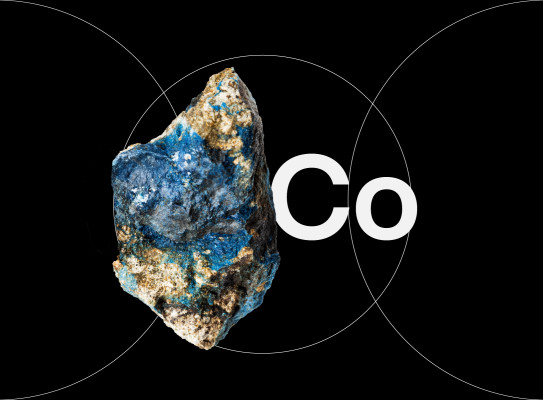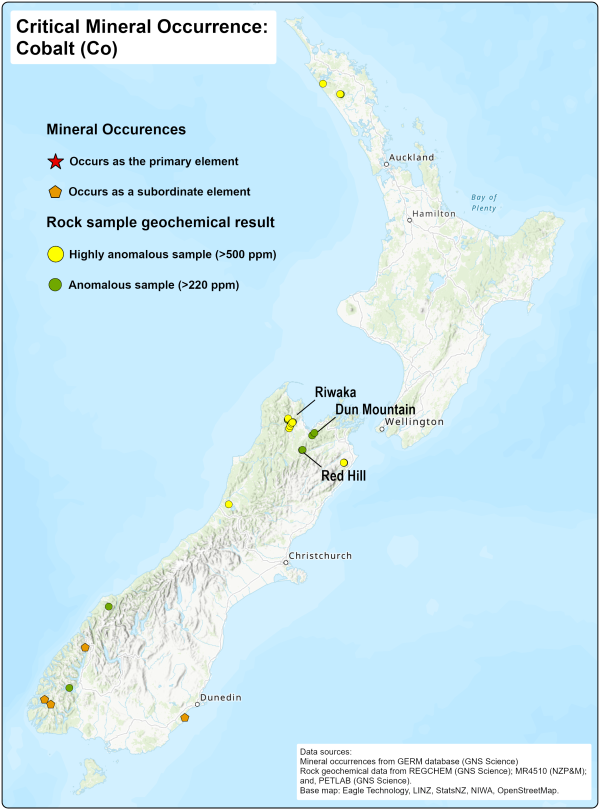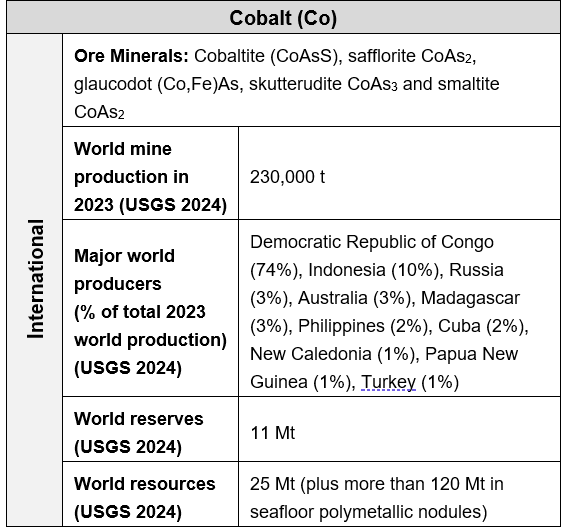Cobalt

Cobalt (Co) is a strategic metal essential for modern technology, renewable energy, and industry. It is primarily used in high-performance batteries, superalloys, and catalysts, making it a key element in the transition to a low-carbon economy. Its role in lithium-ion batteries is crucial for electric vehicles (EVs), energy storage systems, and portable electronics.
Cobalt in New Zealand
A limited range of cobalt-bearing minerals have been observed in New Zealand and include the following: wairauite, cobaltite, glaucodot and linnaeite. Wairauite was first identified in the Red Hills in Marlborough as minute grains in serpentinite (Challis and Long 1964). Nickel and cobalt have been noted in analyses of ore from copper mines in the east Nelson Dun Mountain Ophiolite Belt.
Any likely future production of cobalt in New Zealand would be as a by-product of mining one of New Zealand’s nickel prospects, e.g. Riwaka.
Global Supply & Strategic Importance
The Democratic Republic of Congo (DRC) dominates cobalt production, supplying over 70% of the world’s output. However, geopolitical risks, ethical mining concerns, and supply chain vulnerabilities have increased interest in diversifying sources, including new mining projects in Australia, Canada, and Indonesia, as well as deep-sea exploration.
Geological Occurrence
- Cobalt is typically found as a byproduct of nickel and copper mining, though primary cobalt deposits also exist. The main geological sources include:
- Sediment-hosted deposits – Largest global source, found in Copperbelt-type deposits (e.g., Democratic Republic of Congo, Zambia).
- Magmatic Ni-Cu-Co sulfide deposits – Associated with mafic-ultramafic rocks (e.g., Norilsk-Talnakh, Russia; Sudbury, Canada).
- Laterite deposits – Formed by tropical weathering of ultramafic rocks, enriched in nickel and cobalt (e.g., New Caledonia, Indonesia).
- Cobalt-rich manganese nodules & crusts – Found on the deep-sea floor, representing a potential future resource.


Exploration & Future Prospects
With the growing demand for electric vehicles, renewable energy, and high-tech industries, cobalt exploration is expanding into underexplored regions and deep-sea deposits. Advances in geophysical surveys, remote sensing, and geochemical exploration are helping identify new resources.
Cobalt’s unique properties and its critical role in modern technology make it one of the most sought-after minerals today. As the world shifts towards a greener economy, the demand for cobalt will continue to rise, driving further exploration and innovation in sustainable mining practices.
Key uses of Cobalt
Battery Technology
Cobalt is a key component in lithium-ion batteries, improving energy density and battery life, particularly in nickel-cobalt-manganese (NCM) and nickel-cobalt-aluminium (NCA) cathodes used in EVs.
Superalloys
Cobalt-based superalloys are used in jet engines, gas turbines, and aerospace components due to their high-temperature strength and corrosion resistance.
Magnets & Electronics
Cobalt is used in permanent magnets for wind turbines, electric motors, and advanced electronics.
Catalysts & Chemicals
Cobalt catalysts are essential in petrochemical refining, synthetic fuel production, and desulfurization processes.
Medical & Biological Applications
Cobalt-60, a radioactive isotope, is used in cancer treatment, sterilization, and medical imaging. Cobalt is also an essential trace element for vitamin B12, necessary for human health.
Additional Reading
Durance PMJ, Hill MP, Turnbull RE, Morgenstern R, Rattenbury MS. 2018. Nickel and cobalt mineral potential in New Zealand. Lower Hutt (NZ): GNS Science. 223 p. Consultancy Report 2018/64. Prepared for New Zealand Petroleum and Minerals.